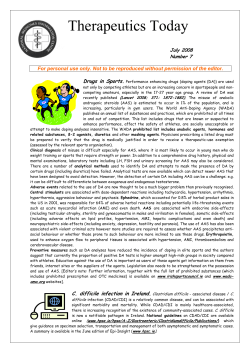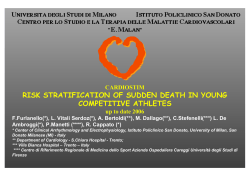
Ischemic Stroke Related to Anabolic Abuse
80 CLINICAL NEUROPHARMACOLOGY Case Report Volume 31, Number 2 March - April 2008 Ischemic Stroke Related to Anabolic Abuse Rodrigo Daniel Santamarina, MD, Ana Gabriela Besocke, MD, Lucas Martin Romano, MD, Pablo Leonardo Ioli, MD, and Sergio Eduardo Gonorazky, MD Abstract Anabolic-androgenic steroid (AAS) abuse increased in recent years, and it is associated with numerous adverse effects. Few reports on ischemic stroke related to anabolic steroid abuse have been published. We report a case of a 26-year-old male amateur athlete who suffered a posterior territory ischemic stroke. No abnormalities were found in angiography and echocardiography studies, neither in hemostatic profile. His only significant risk factor was nonmedical use of stanozolol, an anabolic steroid. Anabolic steroids are capable of increasing vascular tone, arterial tension, and platelet aggregation; therefore, they are prone to produce atherothrombotic phenomena. Because of young people’s widespread use of anabolic steroids, physicians should be aware of this kind of complication. Key Words: cerebrovascular accident, ischemic stroke, anabolic-androgenic steroids, stanozolol, anabolic abuse, substance-related disorders (Clin Neuropharmacol 2008;31:80Y85) I Neurology Department, Hospital Privado de Comunidad, Mar del Plata, Argentina. Address correspondence and reprint requests to Rodrigo Daniel Santamarina, MD, Neurology Department, Hospital Privado de Comunidad, Mar del Plata, B7602CBM, Córdoba 4545, Argentina; E-mail: rsantamarina@ sna.org.ar. Copyright Ó 2008 by Lippincott Williams & Wilkins schemic strokes (ISs) among young people occurring in patients younger than 45 years old have been considered relatively rare events, representing less than 5% of all cerebral infarctions,1,2 although more than 10% of these have also been reported.3,4 These patients differ as regards etiology, pathophysiology, prognosis, and morbidity. Few reports on IS related to AAS abuse have been produced, and its physiopathological mechanism has not been established yet.5Y8 We report a patient who suffered a posterior territory IS associated to stanozolol use. CASE REPORT We report a 26-year-old right-handed white male amateur athlete with a history of stanozolol consumption (10 mg daily) continuously for 3 months before the episode. He had no significant past medical illnesses, no relevant family history, no smoking habits, and no known history of other drug use. He was admitted in the emergency department because of global headache and vomiting, followed by loss of consciousness. Clinical examination revealed decerebration posture, anisocoria (mildly dilated and fixed left pupil), and left eye abduction palsy. Unenhanced cerebral computed tomographic scan was normal. He was transferred to the intensive care unit, and he had to be intubated and ventilated for 15 days. Nasogastric tube feeding was also instituted. Cerebral magnetic resonance imaging (MRI) (Figs. 1, 2) showed ischemic lesions in the left superior region of the vermis, bilateral corticosubcortical occipital lobes, both thalamus, and the left cerebral peduncle in the midbrain. An MRI angiography of the neck vessels, digital cerebral angiography with vein and arterial sequences, transthoracic, and transesophageal echocardiography were performed. No abnormalities were found. Routine laboratory testing was normal. Lipid, thrombophilic, and immunologic profiles were performed (Table 1). Protein S activity, total cholesterol, high-density lipoprotein (HDL) cholesterol, and erythrocyte sedimentation rate were slightly increased, apolipoprotein B was frankly elevated, and the other parameters were normal. Human immunodeficiency virus test was negative, and urinary levels of illicit drug metabolites were normal. The cerebrospinal fluid analysis was normal. The patient was extubated 15 days after his admission. On examination, he was able to obey simple verbal commands; he had anisocoria, disconjugate gaze with nuclear palsy, global aphasia, right hemiparesis with brisk tendon jerks, and no right plantar response. He started inhospital rehabilitation. Forty-five days after his admission, the patient was alert, with right hemiparesis, spasticity and hyperreflexia, limitation of the ocular movements, mixed aphasia, and severe dysarthria. He was able to eat with help. He was discharged with severe disability (Barthel scale, 10; modified Rankin scale, 5). DISCUSSION During the past 2 decades, patients with lipodermatosclerosis, hereditary angioedema, DOI: 10.1097/WNF.0b013e3180ed4485 Copyright @ 2008 Lippincott Williams & Wilkins. Unauthorized reproduction of this article is prohibited. Ischemic Stroke Related to Anabolic Abuse CLINICAL NEUROPHARMACOLOGY Volume 31, Number 2 March - April 2008 FIGURE 1. Axial T2-weighted MRI show ischemic lesions in bilateral corticosubcortical occipital lobes and both thalamus. or Raynaud phenomenon have been treated with stanozolol administered in relatively lowdoses (2 mg daily).9,10 However, the AAS abuse has increased and extended in the last few years among professional and amateur athletes, and lately, also among common people.11,12 Anabolic-androgenic steroids were mostly used as performance-enhancing drugs by young athletes and body builders for muscle development. Its use has also been associated with abuse of other illicit drugs.12 Many adverse effects are well documented. Some of them include arterial hypertension, cardiopathy, cerebrovascular disease, lipid metabolism alterations, infertility, hepatocellular carcinoma, and psychiatric symptoms.5Y7,11 There are few reports of IS related to AAS use. As in our case, most authors have reported young athletes with no vascular risk factor.5Y8 The duration of AAS use was variable, from 6 weeks7 to 4 years,6 and with different anabolic drugs. One of the first case reports of IS associated with supratherapeutic dose of anabolic was a 21-year-old man after self-administration of testosterone enanthate for the treatment of hypogonadotropic hypogonadism for a period of 8 months.13 A possible thrombogenic mechanism has been proposed.6,13 Laroche8 reported a 28-year-old bodybuilder who had an IS caused by a carotid artery thrombus that partially embolized to the brain and, soon after, an ischemic episode in a lower limb caused by a diffused distal arterial thrombosis. Shiozawa et al14 described sinus thrombosis in 3 of a series of 27 hypoplastic anemia patients treated with fluoxymesterone and methenoloneenanthate. Later, the same authors reported hemorrhagic cerebral infarction in a 22-yearold man with hypoplastic anemia after having been treated for 2 months with oxymetholone.15 Although there is no direct evidence that AAS abuse is the cause of atherogenesis, it has been associated with changes in vascular reactivity, lipid profile, hemostasis, and platelet aggregation.16Y18 Vascular compliance has been proposed as an independent predictor of cardiovascular disease.19 Despite the prevalent use of AAS, the covert nature of their use, the diversity of compounds abused, and the duration and route of administration may explain the limited and conflicting data concerning their effects on vascular function.20 To clarify the vascular FIGURE 2. Sagittal T2-weighted MRI show infarct in left superior region of the vermis and the left cerebral peduncle in the midbrain. Copyright @ 2008 Lippincott Williams & Wilkins. Unauthorized reproduction of this article is prohibited. 81 82 CLINICAL NEUROPHARMACOLOGY Santamarina et al Volume 31, Number 2 March - April 2008 TABLE 1. Laboratory Findings Thrombophilic profile Prothrombin time (%) APTT (s) Fibrinogen (mg dLj1) IgG anticardiolipin antibody (GPL) IgM anticardiolipin antibody (MPL) Lupic anticoagulant antibody Antithrombin III (%) Protein S activity (%) Protein C chromogenic activity (%) Activated protein C resistance Homocysteine (2M) Prothrombin G20210A mutation Lipid profile Total cholesterol (mg dLj1) HDL cholesterol (mg dLj1) LDL cholesterol (mg dLj1) LDL-C/HDL-C relation Triglycerides (mg dLj1) Apolipoprotein A (mg dLj1) Apolipoprotein B (mg dLj1) Immunologic profile Erythrocyte sedimentation rate (mm hj1) Antineutrophil cytoplasm antibodies Antinuclear antibodies Rheumatoid factor Result Normal Range 95 32 400 7 75Y100 30Y44 200Y400 1Y15 5 1Y18 Negative 101 150 95 2.93 5.60 Negative 80Y120 56Y120 70Y130 2Y4 5Y15 203 120Y200 60 35Y55 134 100Y140 2.23 40 0Y3 38Y200 110 110Y310 287 58Y138 18 1Y15 Negative V Negative Negative V V APTT indicates activated partial thromboplastin time; GPL, IgG phospholipid binding units; IgM phospholipid binding units. effects of AAS, a recent study20 assessed vascular stiffness (pulse-wave analysis) in 4 groups: (1) 10 bodybuilding subjects were actively receiving anabolic agents (1 using stanozolol), (2) 8 had undergone a 3-month ‘‘wash-out,’’ and (3) 10 denied any past use of anabolic steroids. Comparisons were made with (4) 10 sedentary male controls. Individuals were excluded from the study if they were smokers or known to suffer from ischemic heart disease, diabetes mellitus, or hypertension. The glycerol trinitrate administration reduced the augmentation index (AIx, defined as the difference between the first and second peaks of the central arterial waveform, expressed as a percentage of the pulse pressure) in all 4 groups. However, the percentage reduction of AIx was significantly less in the current AAS users compared with the other 3 groups, indicating reduced endothelial-independent vasodilatation in these subjects. There were no differences between the percentage change in AIx and the other 3 groups, suggesting recovery of vasomotor function after the cessation of AAS. This study (one of the largest studies published on this topic) revealed a reduction in vascular reactivity associated with AAS use. Improvements in vascular reactivity were observed after a 3-month period of abstinence from AAS, which would imply a degree of reversibility after discontinuation of anabolic agents. The most pronounced effects on serum lipids and lipoproteins seem to be exerted by the oral 17-a-alkylated steroids (methandrostenolone, stanozolol, and oxymetholone).21 In fact, there is evidence that suggests that stanozolol significantly reduces HDL cholesterol (HDL-C) levels and increases lowdensity lipoprotein (LDL) cholesterol (LDL-C) without changes in total cholesterol (TC) levels.22 In a study that compared selfadministration of supratherapeutic doses of AAS to volunteers during 14 weeks, serum concentrations of TC, triglycerides, HDL-C, apolipoprotein A-I (ApoA-I), apolipoprotein B (Apo-B), and lipoprotein (a) were determined.21 Patients with AAS use decreased serum concentrations of HDL-C and ApoA-I, whereas Apo-B was increased (Apo-B was increased in our patient as well). Total cholesterol and triglycerides did not change significantly. These alterations led to an Ó 2008 Lippincott Williams & Wilkins Copyright @ 2008 Lippincott Williams & Wilkins. Unauthorized reproduction of this article is prohibited. Ischemic Stroke Related to Anabolic Abuse CLINICAL NEUROPHARMACOLOGY Volume 31, Number 2 March - April 2008 increased atherogenic lipid profile. However, because lipoprotein (a) also declined, the risk of vascular disease is still uncertain. The effect on lipids and lipoproteins was not influenced by the duration of AAS use, although the time to reach normal values after cessation was longer in patients with prolonged use of the drug. Apolipoprotein B has emerged as a more powerful risk factor than the conventional cholesterol indices.23 It is a better predictor of cardiovascular events than nonYHDL-C and LDL-C, and it has been experimentally linked to the development of atherosclerosis, mediating the interaction between LDL-C and the arterial wall. This is particularly the case of patients with relatively normal levels of LDL-C because for these patients, the risk of IS seems to be more closely related to the increased amount of small dense LDL. The last ones are the most atherogenic particles because they easily oxidize and promote inflammatory response and growth of plaques.24,25 Apolipoprotein B transports all potentially atherogenic very low-density lipoprotein, intermediate-density lipoprotein and LDL particles, and ApoA-I transports and acts as the major antiatherogenic protein in the HDL particles.24 The Apo-B/ApoA-I ratio has been shown to be strongly related to risk of myocardial infarction, stroke, and other cardiovascular manifestations as shown in the Apolipoproteinrelated Mortality Risk and INTERHEART studies.24 In the Apolipoprotein-related Mortality Risk study, high Apo-B and low ApoA-I values were significantly related to risk of stroke, and the strongest association was with IS. The Apo-B/ApoA-I ratio was linearly related to the risk of stroke, although the slope was less than observed for the risk of fatal myocardial infarction. In multivariate analyses, the Apo-B/ApoA-I ratio was a stronger risk predictor than TC/HDL-C and LDL-C/ HDL-C ratios.24 Currently, the information available about the effect of AAS in hemostasis is limited and not clear enough, possibly due to its interaction with endogen steroids. Evi- dence suggests that stanozolol produces significant enhancement of extrinsic tissue type plasminogen activator activity (t-PA), with reduction of serum fibrinogen, and increases the levels of protein C and antithrombin III.22 However, the final effect of AAS abuse on the hemostatic system may fluctuate from an antithrombotic to a prothrombotic profile. Specifically for stanozolol, this variation may be dose dependent. Using low doses, the profibrinolytic activity predominates, whereas higher doses would yield to a procoagulant state.26 Ferenchick et al27 compared plasma clotting and fibrinolytic activity in 49 weight lifters (32 AAS users and 17 nonusers). History of androgen use was confirmed via urine assays, and the AAS identified were nandrolone decanoate, methandienone, oxymesterone, methyltestosterone, and methenolone. In the confirmed users, an increase of D-dimers, prothrombin activation fragments (F1 + 2), and thrombin/ antithrombin III complexes were found, coupled with the decrease in t-PA antigen and plasminogen activator inhibitor. The authors propose that the elevated levels of thrombin/antithrombin III complexes and F1 + 2 are consistent with increased in vivo thrombin generation, whereas elevated D-dimers suggests androgen mediated both thrombin activation (with consequent fibrin production) and increased plasmin activity. Moreover, the decreased levels of t-PA and plasminogen activator inhibitor are compatible with increased consumption because these proteins are produced by endothelial cells where their rate of resynthesis may be less than those proteins produced by the liver parenchymal cells. These changes can reflect a hypercoagulable state that may contribute to vascular occlusion reported in young athletes using these drugs. Furthermore, high doses of AAS are associated with increased platelet aggregation and may influence the activity of vascular cyclooxygenase enzyme. Androgen abuse has been noted to decrease platelet threshold activation to collagen in weight lifters older than 22 years.17 Copyright @ 2008 Lippincott Williams & Wilkins. Unauthorized reproduction of this article is prohibited. 83 84 CLINICAL NEUROPHARMACOLOGY Santamarina et al Volume 31, Number 2 March - April 2008 There are several reports on myocardial infarction occurring in young patients with only a history of consumption of AAS, including stanozolol.16,28Y34 Angiogram and pathological studies show thrombosis of coronary arteries.28Y32 However, in a report of 2 cases of sudden death due to myocardial infarction associated with AAS abuse, the histopathologic examination does not evidence those changes neither in the coronary arteries nor in other organs.33 In other cases reported in medical reports, angiography lesions at any level of the coronary system were absent.16,33Y34 The development of myocardial infarction in AAS users in the face of normal coronary arteries suggests either coronary spasm, in situ thrombosis, or coronary emboli as possible pathogenic mechanisms.34 Anabolic-androgenic steroids have also been associated with coronary artery vasospasm. In the coronary arteries, nitric oxide increases the activity of guanylyl cyclase, which converts guanosine triphosphate to cyclic guanosine monophosphate, which subsequently stimulates smooth muscle relaxation. The excess LDL-C (caused by exogenous androgens) may oxidize at the arterial endothelium and consequently impair endothelium-dependent arterial relaxation by inhibiting nitric oxide production.35 It remains unclear why some patients develop coronary lesions and why others do not. To conclude, AAS, particularly high doses of stanozolol, increase vascular tone and its reactivity, arterial tension, platelet aggregation, and, therefore, they are prone to produce atherothrombotic phenomena.26 Moreover, the clue to understand atherosclerotic disease in different extracoronary territories is interpreting atherogenesis as a unique and generalized process in all arteries. This process is supported by the similar pathological appearances of all plaque stages at different sites of the vascular system, its common localization in areas of vessel wall stress, and similar risk factor patterns for atherosclerosis in different arterial trees.36 In the case we are reporting, the clinical circumstances suggest a possible causal relationship between AAS abuse and the mechanism of cerebrovascular disease. Considering young people’s widespread use of AAS, physicians should be aware of the complications and side effects that these agents may produce. REFERENCES 1. Marini C, Totaro R, De Santis F, et al. Stroke in young adults in the community-based L’Aquila registry: incidence and prognosis. Stroke 2001; 32(1):52Y56. 2. Jacobs BS, Boden-Albala B, Lin IF, et al. Stroke in the young in the northern Manhattan stroke study. Stroke 2002;33(12):2789Y2793. 3. Siqueira Neto JI, Santos AC, Fabio SR, et al. Cerebral infarction in patients aged 15 to 40 years. Stroke 1996;27(11):2016Y2019. 4. Bogousslavsky J, Van Melle G, Regli F. The Lausanne Stroke Registry: analysis of 1,000 consecutive patients with first stroke. Stroke 1988;19(9): 1083Y1092. 5. Lisiewicz J, Fijalkowski P, Sankowski J. Ischemic cerebral stroke and anabolic steroids (case report). Neurol Neurochir Pol 1999;32(suppl 6):137Y139. 6. Frankle MA, Eichberg R, Zachariah SB. Anabolic androgenic steroids and a stroke in an athlete: case report. Arch Phys Med Rehabil 1988;69(8):632Y633. 7. Akhter J, Hyder S, Ahmed M. Cerebrovascular accident associated with anabolic steroid use in a young man. Neurology 1994;44:2405Y2406. 8. Laroche GP. Steroid anabolic drugs and arterial complications in an athleteVa case history. Angiology 1990;41(11):964Y969. 9. Sheffer AL, Fearon DT, Austen KF. Hereditary angioedema: a decade of management with stanozolol. J Allergy Clin Immunol 1987;80(6): 855Y860. 10. Helfman T, Falanga V. Stanozolol as a novel therapeutic agent in dermatology. J Am Acad Dermatol 1995;33(2 pt 1):254Y258. 11. Bahrke MS, Yesalis CE. Abuse of anabolic androgenic steroids and related substances in sport and exercise. Curr Opin Pharmacol 2004;4(6): 614Y620. 12. Roccella M, Paterno G, Bonanno M, et al. New addictions in the third millennium: anabolic steroids as a substance of abuse. Minerva Pediatr 2005; 57(3):129Y135. 13. Nagelberg SB, Laue L, Loriaux DL, et al. Cerebrovascular accident associated with testosterone therapy in a 21-year-old hypogonadal man. N Engl J Med 1986;314(10):649Y650. 14. Shiozawa Z, Yamada H, Mabuchi C, et al. Superior sagittal sinus thrombosis associated with androgen therapy for hypoplastic anemia. Ann Neurol 1982; 12(6):578Y580. 15. Shiozawa Z, Tsunoda S, Noda A, et al. Cerebral hemorrhagic infarction associated with anabolic Ó 2008 Lippincott Williams & Wilkins Copyright @ 2008 Lippincott Williams & Wilkins. Unauthorized reproduction of this article is prohibited. Ischemic Stroke Related to Anabolic Abuse CLINICAL NEUROPHARMACOLOGY Volume 31, Number 2 March - April 2008 steroid therapy for hypoplastic anemia. Angiology 1986;37(10):725Y730. 16. Godon P, Bonnefoy E, Guerard S, et al. Myocardial infarction and anabolic steroid use. A case report. Arch Mal Coeur Vaiss 2000;93(7):879Y883. 17. Ferenchick GS, Schwartz D, Ball M, et al. Androgenic-anabolic steroid abuse and platelet aggregation: a pilot study in weight lifters. Am J Med Sci 1992;303(2):78Y82. 18. Ferenchick GS. Anabolic/androgenic steroid abuse and thrombosis: is there a connection? Med Hypotheses 1991;35(1):27Y31. 19. Glasser SP, Arnett DK, McVeigh GE, et al. Vascular compliance and cardiovascular disease: a risk factor or a marker? Am J Hypertens 1997; 10(10 pt 1):1175Y1189. 20. Lane HA, Grace F, Smith JC, et al. Impaired vasoreactivity in bodybuilders using androgenic anabolic steroids. Eur J Clin Invest 2006;36(7): 483Y488. 21. Hartgens F, Rietjens G, Keizer HA, et al. Effects of androgenic-anabolic steroids on apolipoproteins and lipoprotein (a). Br J Sports Med 2004;38(3): 253Y259. 22. Kluft C, Preston FE, Malia R, et al. Stanozolol-induced changes in fibrinolysis and coagulation in healthy adults. Thromb Haemost 1984;51(2):157Y164. 23. Sniderman AD, Marcovina SM. Apolipoprotein A1 and B. Clin Lab Med 2006;26(4):733Y750. 24. Walldius G, Jungner I. The apoB/apoA-I ratio: a strong, new risk factor for cardiovascular disease and a target for lipid-lowering therapy–a review of the evidence. J Intern Med 2006;259(5): 493Y519. 25. Olofsson SO, Boren J. Apolipoprotein B: a clinically important apolipoprotein which assembles atherogenic lipoproteins and promotes the development of atherosclerosis. J Intern Med 2005;258(5):395Y410. 26. Winkler UH. Effects of androgens on haemostasis. Maturitas 1996;24(3):147Y155. 27. Ferenchick GS, Hirokawa S, Mammen EF, et al. Anabolic-androgenic steroid abuse in weight lifters: evidence for activation of the hemostatic system. Am J Hematol 1995;49(4):282Y288. 28. Halvorsen S, Thorsby PM, Haug E. Acute myocardial infarction in a young man who had been using androgenic anabolic steroids. Tidsskr Nor Laegeforen 2004;124(2):170Y172. 29. Huie MJ. An acute myocardial infarction occurring in an anabolic steroid user. Med Sci Sports Exerc 1994;26(4):408Y413. 30. Tischer KH, Heyny-von Haussen R, Mall G, et al. Coronary thrombosis and ectasia of coronary arteries after long-term use of anabolic steroids. Z Kardiol 2003;92(4):326Y331. 31. Toyama M, Watanabe S, Kobayashi T, et al. Two cases of acute myocardial infarction associated with aplastic anemia during treatment with anabolic steroids. Jpn Heart J 1994;35(3):369Y373. 32. Mewis C, Spyridopoulos I, Kuhlkamp V, et al. Manifestation of severe coronary heart disease after anabolic drug abuse. Clin Cardiol 1996;19(2): 153Y155. 33. Fineschi V, Baroldi G, Monciotti F, et al. Anabolic steroid abuse and cardiac sudden death. A pathologic study. Arch Pathol Lab Med 2001; 125(2):253Y255. 34. Ferenchick GS, Adelman S. Myocardial infarction associated with anabolic steroid use in a previously healthy 37-year-old weight lifter. Am Heart J 1992; 124(2):507Y508. 35. Sullivan ML, Martinez CM, Gennis P, et al. The cardiac toxicity of anabolic steroids. Prog Cardiovasc Dis 1998;41(1):1Y15. 36. Liu P, Death A, Handelsma DJ. Androgens and cardiovascular disease. Endocr Rev 2003;24(3): 313Y340. Copyright @ 2008 Lippincott Williams & Wilkins. Unauthorized reproduction of this article is prohibited. 85
© Copyright 2025

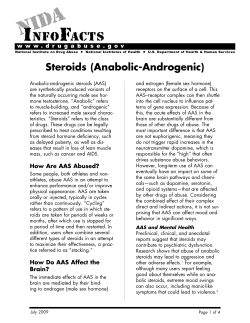
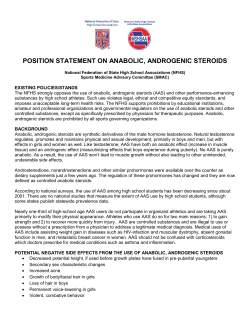
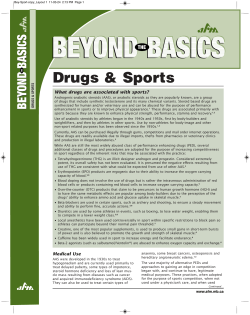
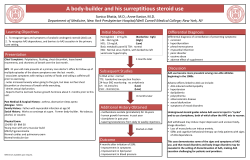



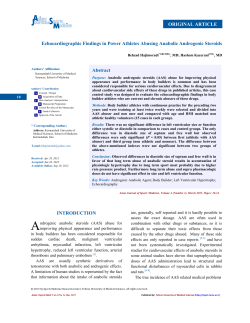


![” ⊙ Prohibited Substances [1] Anabolic-Androgenic Steroids](http://cdn1.abcdocz.com/store/data/000006330_2-6488874179c020189ebf4ca4aba01440-250x500.png)
